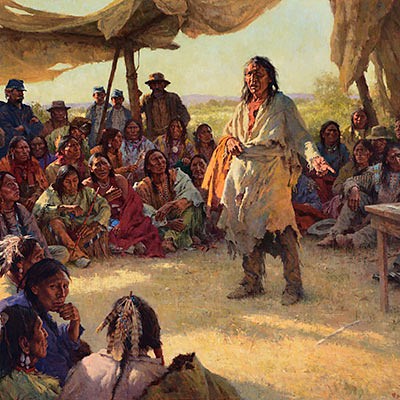William Herbert Dunton (1878 – 1936) — Two Braves (ca. 1916)
Lot 201
About Seller
Coeur d'Alene Art Auction
11944 North Tracey Road
Hayden, ID 83835
United States
Coeur d’Alene Art Auction specializes in the finest classical Western and American Art representing past masters and outstanding contemporary artists. The auction principals have over 100 years of combined experience in selling fine art and have netted their clients over $325 million in the last fif...Read more
Estimate:
$300,000 - $500,000
Absentee vs Live bid
Two ways to bid:
- Leave a max absentee bid and the platform will bid on your behalf up to your maximum bid during the live auction.
- Bid live during the auction and your bids will be submitted real-time to the auctioneer.
Bid Increments
| Price | Bid Increment |
|---|---|
| $0 | $100 |
| $2,000 | $250 |
| $5,000 | $500 |
| $10,000 | $1,000 |
| $20,000 | $2,500 |
| $50,000 | $5,000 |
| $100,000 | $10,000 |
| $200,000 | $25,000 |
| $500,000 | $50,000 |
| $1,000,000 | $100,000 |
About Auction
By Coeur d'Alene Art Auction
Jul 15, 2023
Set Reminder
2023-07-15 15:00:00
2023-07-15 15:00:00
America/New_York
Bidsquare
Bidsquare : Fine Western & American Art
https://www.bidsquare.com/auctions/coeur-dalene/fine-western-american-art-12980
The 2023 Coeur d’Alene Art Auction, to be held July 15 in Reno, Nevada, will feature 324 selections of unparalleled quality in Western & American Art from historical and contemporary artists such as Maynard Dixon, Howard Terpning, W. Herbert Dunton, Joseph H. Sharp, Charles M. Russell, and more. Coeur d'Alene Art Auction info@cdaartauction.com
The 2023 Coeur d’Alene Art Auction, to be held July 15 in Reno, Nevada, will feature 324 selections of unparalleled quality in Western & American Art from historical and contemporary artists such as Maynard Dixon, Howard Terpning, W. Herbert Dunton, Joseph H. Sharp, Charles M. Russell, and more. Coeur d'Alene Art Auction info@cdaartauction.com
- Lot Description
William Herbert Dunton (1878 – 1936)
Two Braves (ca. 1916)
oil on canvas
39 × 26 inches
signed lower left
VERSO
Label, J. N. Bartfield Galleries, New York, New York
Two Braves will be included in Michael R. Grauer’s forthcoming W. Herbert Dunton Catalogue Raisonné.
According to art historian Michael R. Grauer, “Between about 1909 and 1918 in both Mexico and the area around Taos, Dunton posed and painted en plein air lone American Indians or cowboys, or groups of American Indians or cowboys, and sometimes vaqueros. In this series of vertical paintings of American Indians – which probably incorporate the same model posed in the same spot in the Taos desert or mountains – all done between about 1912 and 1916, and usually either 20 by 16 or 16 by 12 inches. These include Winter Camp of the Sioux; Blackfeet; The Chief; Crows; and Crow Outlier. Two Braves is considerably larger than the other paintings in this group.
“The paintings in this ‘series’ also exhibit the same expressive brushwork and heavy impasto, a characteristic Dunton learned from the American Impressionists whose work he saw in Boston and New York from 1903 to 1915. Having been a studio painter formerly, Dunton promoted his role as a plein air – and therefore avant-garde – painter after 1912. The New York Herald (1914) reported that ‘he paints right out of doors – begins, finishes and even signs his paintings out in the open.’ And Scribner’s (1916) noted that Dunton ‘believes in painting direct from nature, and spares himself no trouble to get his effects, setting forth at times with models and half a dozen ponies … to paint them in a wind-storm, with his canvas anchored against the stiff breeze by big boulders.’
“Dunton’s rendering of the sage and chamisa in the foreground of Two Braves as well as his depictions of the cliffs in the middle and background, and the procession in the canyon bottom, demonstrate how he toyed with the dissolution of forms through dynamic brushwork, common to impressionist painting. We also see in the sky and clouds in the background an almost pointilliste brushstroke. The juxtaposition of these components with the square-jawed look of the main figure, along with his distinctive hairstyle often associated with the Blackfeet, and his lance, quiver, shield, red beaded moccasins, and sitting on a buffalo robe while riding his paint horse, speak to Dunton’s extensive knowledge of Northern Plains tribes. The procession in the canyon bottom, including a woman with cradleboard on her back riding a black horse pulling a travois, underscores Dunton’s skill in building a complete Northern Plains domestic scene. Moreover, none of the ‘braves’ are painted for war, so this could be described as a ‘moving camp’ composition.
“Two Braves also shows the influence of Frederic Remington and Charles M. Russell on Dunton’s work. Dunton recognized both as ‘Old Masters’ of Western art. After Remington died in 1909, some critics even felt only Dunton possessed the ‘ability to carry on the work where [Frederic] Remington left off’ and he was called ‘the Remington of the Southwest.’”
PROVENANCE
H. Clayton Peterson, Denver, Colorado, 1980
Present owner, by descent
View More InformationSurface is in good condition. Canvas is lined. Hairline cracks in the sky with small spots of inpainting.Condition
- Buyer's Premium



 EUR
EUR CAD
CAD AUD
AUD GBP
GBP MXN
MXN HKD
HKD CNY
CNY MYR
MYR SEK
SEK SGD
SGD CHF
CHF THB
THB













